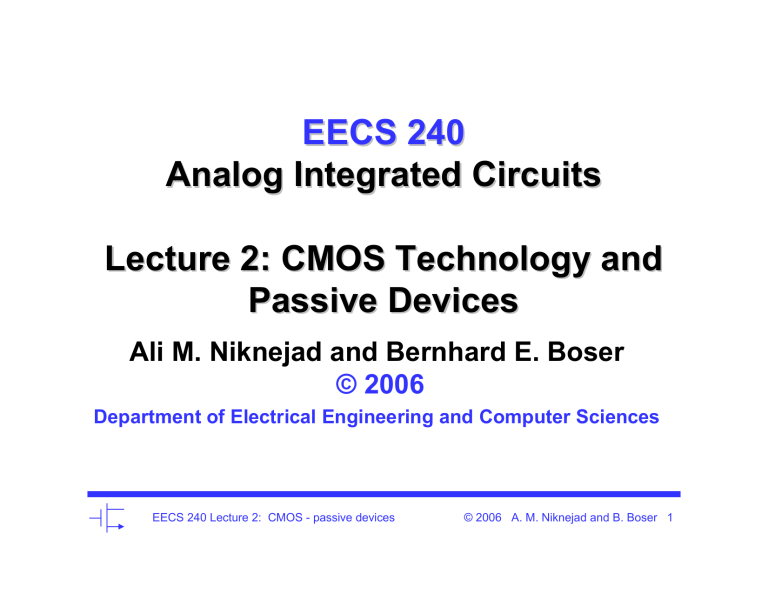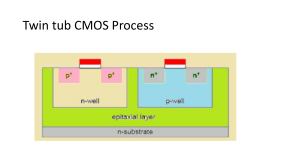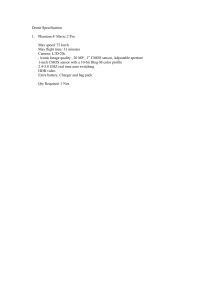
EECS 240 Analog Integrated Circuits Lecture 2: CMOS Technology and Passive Devices Ali M. Niknejad and Bernhard E. Boser © 2006 Department of Electrical Engineering and Computer Sciences EECS 240 Lecture 2: CMOS - passive devices © 2006 A. M. Niknejad and B. Boser 1 CMOS Technology • Why look at it (again)? • Key issues: 1. Perspective – Device dimensions – Device performance metrics, e.g.: – – – – Current efficiency Speed Gain Noise 2. “Short-channel characteristics” – Square-law model – Models for circuit simulation – Design EECS 240 Lecture 2: CMOS - passive devices © 2006 A. M. Niknejad and B. Boser 2 Today’s Lecture • CMOS cross-section • Passive devices – Resistors – Capacitors • Next time: MOS transistor EECS 240 Lecture 2: CMOS - passive devices © 2006 A. M. Niknejad and B. Boser 3 CMOS Process • EECS240 0.18µm 1P6M CMOS – – – – Minimum channel length: 0.18µm 1 level of polysilicon 6 levels of metal (Cu) 1.8V supply • Other choices – Shorter channel length (90 nm / 1V) – Bipolar, SiGe HBT – SOI EECS 240 Lecture 2: CMOS - passive devices © 2006 A. M. Niknejad and B. Boser 4 Supply Voltage Supply Voltage [V] 5 4 3 2 1 0 1 0.8 0.5 0.35 0.25 0.18 0.12 0.08 0.06 Feature Size [µm] EECS 240 Lecture 2: CMOS - passive devices © 2006 A. M. Niknejad and B. Boser 5 CMOS Cross Section Metal p- substrate p+ diffusion Poly n- well n+ diffusion EECS 240 Lecture 2: CMOS - passive devices © 2006 A. M. Niknejad and B. Boser 6 Dimensions ≥ 0.35µm 6.5nm 200nm 1.2mµ 700mµ Drawing is not to scale! EECS 240 Lecture 2: CMOS - passive devices © 2006 A. M. Niknejad and B. Boser 7 Devices • Active – NMOS, PMOS – NPN, PNP – Diodes • Passive – Resistors – Capacitors – Inductors EECS 240 Lecture 2: CMOS - passive devices © 2006 A. M. Niknejad and B. Boser 8 Resistors • • No provisions in standard CMOS Resistors are bad for digital circuits Æ – Minimized in standard CMOS • Sheet resistance of available layers: Layer Aluminum Polysilicon N+/P+ diffusion N-well • Sheet resistance 60 mΩ/ 5 Ω/ 5 Ω/ 1 kΩ/ Example: 100kΩ poly resistor Æ 1µm wide by 20,000µm long EECS 240 Lecture 2: CMOS - passive devices © 2006 A. M. Niknejad and B. Boser 9 Process Options • Available for many processes • Add features to “baseline process” • E.g. – – – – – – Capacitor option (MIM, 2 level poly, channel implant) Low VTH devices “High voltage” devices (3.3V) EEPROM Silicide stop option … EECS 240 Lecture 2: CMOS - passive devices © 2006 A. M. Niknejad and B. Boser 10 Silicide Technology • Implants used to lower resistance of source/drain and polysilicon. • Titanium Silicide (TiSi2) is widely used salicide (self-aligned silicide), has low resistivity (13-17 mΩ-cm) with melting point of 1540˚C. Another widely used silicide is CoSi2. • Platinum Silicide (PtSi) is a highly reliable contact metallization between the silicon substrate and the metal layers (Al). EECS 240 Lecture 2: CMOS - passive devices © 2006 A. M. Niknejad and B. Boser 11 Silicide Block Option Layer N+ poly P+ poly N+ diffusion P+ diffusion N-well R/ [Ω/ ] 100 180 50 100 1000 TC [ppm/oC] @ T = 25 oC -800 200 1500 1600 -1500 VC [ppm/V] BC [ppm/V] 50 50 500 500 20,000 50 50 -500 -500 30,000 • Non-silicided layers have significantly larger sheet resistance • Resistor nonidealities: – Temperature coefficient: R = f(T) – Voltage coefficient: R = f(V) EECS 240 Lecture 2: CMOS - passive devices © 2006 A. M. Niknejad and B. Boser 12 Resistor Example Goal: R = 100 kΩ, TC = 1/R x dR/dT = 0 Solution: combination of N+ and P+ poly resistors in series R = RN (1 + TCN ∆T ) + RP (1 + TCP ∆T ) = RN + RP + (RN TCN + RPTCP )∆T 1 424 3 1442443 R RN = R RP = R ⇒ 0 1 = 20kΩ = 200 squares TCN 1− TCP 1 = 80kΩ = 444.4 squares TCP 1− TCN EECS 240 Lecture 2: CMOS - passive devices © 2006 A. M. Niknejad and B. Boser 13 Voltage Coefficient - p substrate p diffusion n- well n+ diffusion V1 Example: Diffusion resistor + V2 Æ Applied voltage modulates depletion width (cross-section of conductive channel) VB Æ Well acts as a shield R V1 − V2 I V +V ≈ Ro 1 + TC (T − 25o ) + VC (V1 − V2 ) + BC 1 2 − VB 2 R= EECS 240 Lecture 2: CMOS - passive devices © 2006 A. M. Niknejad and B. Boser 14 Resistor Matching • Types of mismatch – Systematic (e.g. contacts) – Run-to-run variations – Random variations between devices • Absolute resistor value – E.g. filter time constant, bias current (BG reference) – ~ 15 percent variations (or more) • Resistor ratios – E.g. opamp feedback network – Insensitive to absolute resistor value – “unit-element” approach rejects systematic variations (large area for non-integer ratios) – Process gradients – 0.1 … 1 percent matching possible with careful layout EECS 240 Lecture 2: CMOS - passive devices © 2006 A. M. Niknejad and B. Boser 15 Resistor Layout Example: R1 : R2 = 1 : 2 gradient Dummy Æ 0.5 * R2 + ∆R R1 0.5 * R2 - ∆R Dummy Æ EECS 240 Lecture 2: CMOS - passive devices © 2006 A. M. Niknejad and B. Boser 16 Resistor Layout (cont.) Serpentine layout for large values: Better layout (mitigates offset due to thermoelectric effects): See Hastings, “The art of analog layout,” Prentice Hall, 2001. EECS 240 Lecture 2: CMOS - passive devices © 2006 A. M. Niknejad and B. Boser 17 MOSFETs as Resistors • Triode region (“square law”): I D = µCox • W L V VGS − VTH − DS VDS 2 for VGS − VTH > VDS Small signal resistance: W 1 ∂I = D = µCox (VGS − VTH − VDS ) L R ∂VDS R≈ • 1 W µCox (VGS − VTH ) L for VGS − VTH >> VDS Voltage coefficient: VC = 1 ∂R 1 = R ∂VDS VGS − VTH − VDS EECS 240 Lecture 2: CMOS - passive devices © 2006 A. M. Niknejad and B. Boser 18 MOS Resistors Example: R = 1 MΩ R≈ 1 W (VGS − VTH ) L 1 W = L µCox R (VGS − VTH ) µCox 1 = 100 VC V DS = 0V µA × 1MΩ × 2 V V2 1 = VGS − VTH = 1 = 0.5V −1 2V = 1 200 • • Large R-values realizable in small area Very large voltage coefficient • Applications: – MOSFET-C filters: (linearization) Ref: Tsividis et al, “Continuous-Time MOSFET-C Filters in VLSI,” JSSC, pp. 15-30, Feb. 1986. – Biasing: (>1GΩ) Ref: Geen et al, “Single-Chip SurfaceMicromachined Integrated Gyroscope with 50o/hour Root Allen Variance,” ISSCC, pp. 426-7, Feb. 2002. EECS 240 Lecture 2: CMOS - passive devices © 2006 A. M. Niknejad and B. Boser 19 Resistor Summary • No or limited support in standard CMOS – Costly: large area (compared to FETs) – Nonidealities: • Large run-to-run variations • Temperature coefficient • Voltage coefficients (nonlinear) • Avoid them when you can – Especially in critical areas, e.g. • Amplifier feedback networks • Electronic filters • A/D converters – We will get back to this point EECS 240 Lecture 2: CMOS - passive devices © 2006 A. M. Niknejad and B. Boser 20 Capacitor Applications • Large value – Bypass capacitors – Frequency compensation • High accuracy, linearity – Feedback & sampling networks – Filters EECS 240 Lecture 2: CMOS - passive devices © 2006 A. M. Niknejad and B. Boser 21 Capacitor Options Type C [aF/µm2] VC [ppm/V] TC [ppm/oC] Gate 5300 Huge Big Poly-poly (option) 1000 10 25 Metal-metal 50 20 30 Metal-substrate 30 Metal-poly 50 Big Big Poly-substrate Junction capacitors 120 ~ 1000 EECS 240 Lecture 2: CMOS - passive devices © 2006 A. M. Niknejad and B. Boser 22 MOS Capacitor • High capacitance in inversion: – Linear region – Strong inversion • SPICE: I ωV V = 1V ω =1 →C = I C= EECS 240 Lecture 2: CMOS - passive devices © 2006 A. M. Niknejad and B. Boser 23 MOS Capacitor • High non-linearity, temperature coefficient • Useful only for non-critical applications, e.g. – (Miller) compensation capacitor – Bypass capacitor (supply, bias) EECS 240 Lecture 2: CMOS - passive devices © 2006 A. M. Niknejad and B. Boser 24 Poly-Poly Capacitor • Applications: – Feedback networks – Filters (SC and continuous time) – Charge redistribution DACs & ADCs • Cross-section • Bottom- and top-plate parasitics • Shields EECS 240 Lecture 2: CMOS - passive devices © 2006 A. M. Niknejad and B. Boser 25 Capacitor Layout • • • • Unit elements Shields: • Etching • Fringing fields “Common-centroid” Wiring and interconnect parasitics Ref.: Y. Tsividis, “Mixed Analog-Digital VLSI Design and Technology,” McGraw-Hill, 1996. EECS 240 Lecture 2: CMOS - passive devices © 2006 A. M. Niknejad and B. Boser 26 Metal Capacitors • Available in all processes (with at least 2 levels of metalization) • Large bottom plate parasitic – Often loads amplifier Æ increased load adds power dissipation EECS 240 Lecture 2: CMOS - passive devices © 2006 A. M. Niknejad and B. Boser 27 MIM Capacitors • Many processes have add-on options such as a MIM capacitor. • This is simply a metal-insulator-metal (MIM) structure situated in the oxide layers. The insulator is a very thin layer (~25 nm), resulting in high density and relatively low back-plate parasitics. EECS 240 Lecture 2: CMOS - passive devices © 2006 A. M. Niknejad and B. Boser 28 Custom “MOM” Capacitors • Metal-Oxide-Metal capacitor. Free with modern CMOS. • Use lateral flux (~Lmin) and multiple metal layers to realize high capacitance values EECS 240 Lecture 2: CMOS - passive devices © 2006 A. M. Niknejad and B. Boser 29 MOM Capacitor Cross Section • Use a wall of metal and vias to realize high density. • Use as many layers as possible. Use fewer layers to minimize backplate parasitics. • Reasonably good matching and accuracy. EECS 240 Lecture 2: CMOS - passive devices © 2006 A. M. Niknejad and B. Boser 30 Commercial BiCMOS Process www.ibm.com/chips/techlib/techlib.nsf/techdocs/FE154539B8C4C01687256CD9007346D7/$file/180-nmCMOS3-24-04.pdf EECS 240 Lecture 2: CMOS - passive devices © 2006 A. M. Niknejad and B. Boser 31 Typical 180nm CMOS www.ibm.com/chips/techlib/techlib.nsf/techdocs/FE154539B8C4C01687256CD9007346D7/$file/180-nmCMOS3-24-04.pdf • Leff < L • High volage IO devices • High voltage device has thick oxide EECS 240 Lecture 2: CMOS - passive devices © 2006 A. M. Niknejad and B. Boser 32 Triple Well Option n-well p-well deep n-well p-sub • Many modern process have a triple well (deep well) option that allows NFETs to be isolated from the substrate. Older notation: twin-well. • This provides better immunity from digital noise in a mixed signal circuit. EECS 240 Lecture 2: CMOS - passive devices © 2006 A. M. Niknejad and B. Boser 33 Isolation Options www.ibm.com/chips/techlib/techlib.nsf/techdocs/FE154539B8C4C01687256CD9007346D7/$file/180-nmCMOS3-24-04.pdf EECS 240 Lecture 2: CMOS - passive devices © 2006 A. M. Niknejad and B. Boser 34 Bipolar Devices www.ibm.com/chips/techlib/techlib.nsf/techdocs/FE154539B8C4C01687256CD9007346D7/$file/180-nmCMOS3-24-04.pdf EECS 240 Lecture 2: CMOS - passive devices © 2006 A. M. Niknejad and B. Boser 35 Passives EECS 240 Lecture 2: CMOS - passive devices © 2006 A. M. Niknejad and B. Boser 36 www.ibm.com/chips/techlib/techlib.nsf/techdocs/FE154539B8C4C01687256CD9007346D7/$file/180-nmCMOS3-24-04.pdf Distributed Effects • Can model IC resistors as distributed RC circuits. • Transmission line analysis yields the equivalent 2port parameters. • Inductance negligible for small IC structures up to ~10GHz. EECS 240 Lecture 2: CMOS - passive devices © 2006 A. M. Niknejad and B. Boser 37 Effective Resistance • Rsh = 100 Ω/□, Cx=3.45×10-5 F/m2 • 10kΩ resistor drops to 5kΩ at 1 GHz ! (W=5µ) • High frequency resistance depends on W. Need distributed model for accurate freq response. EECS 240 Lecture 2: CMOS - passive devices © 2006 A. M. Niknejad and B. Boser 38 Capacitor Q • Current density in capacitor plates drops due to vertical displacement current. • Must analyze the distributed RC circuit… EECS 240 Lecture 2: CMOS - passive devices © 2006 A. M. Niknejad and B. Boser 39 Capacitor Impedance • For a capacitor contacted at one side, we can show that • We can simplify this for small structures EECS 240 Lecture 2: CMOS - passive devices © 2006 A. M. Niknejad and B. Boser 40 Double Contact Strucutre • Instead of doing distributed analysis, we can guess the current distribution as linear and quickly calculate the effective resistance. • For a double contact case, the resistance drops by 4 times. EECS 240 Lecture 2: CMOS - passive devices © 2006 A. M. Niknejad and B. Boser 41 On-Chip Inductors • Once in the domain of RF circuits, now inductors are finding applications in wideband design (e.g. shunt peaking). • By proper design, the bandwidth of the RC circuit can be boosted by 85% (20% peaking). EECS 240 Lecture 2: CMOS - passive devices © 2006 A. M. Niknejad and B. Boser 42 Spiral Inductors • These inductors are small (0.1-10 nH) and are used widely in RF circuits. • Use top metal for high Q and high self resonance frequencies. Very good matching and accuracy. EECS 240 Lecture 2: CMOS - passive devices © 2006 A. M. Niknejad and B. Boser 43 Multi-Layer Inductors Top view 3D view (not to scale) • By taking advantage of multiple metal layers and mutual coupling, we can realize very large inductors (~ 100 nH). EECS 240 Lecture 2: CMOS - passive devices © 2006 A. M. Niknejad and B. Boser 44

